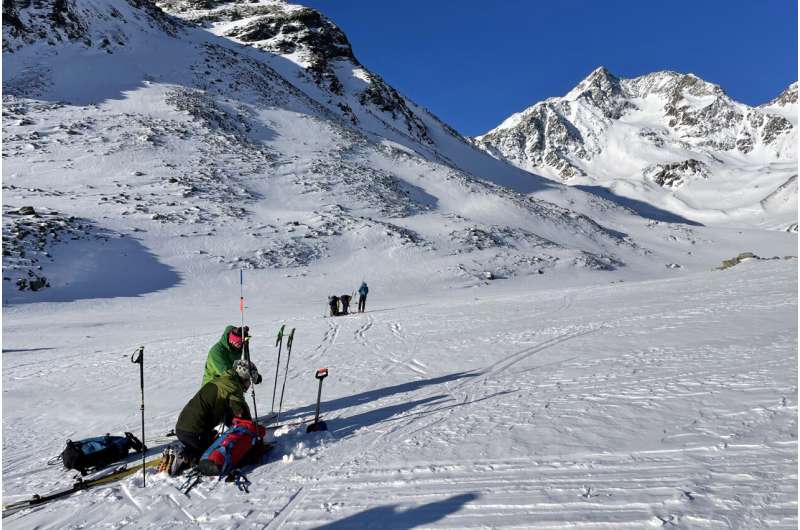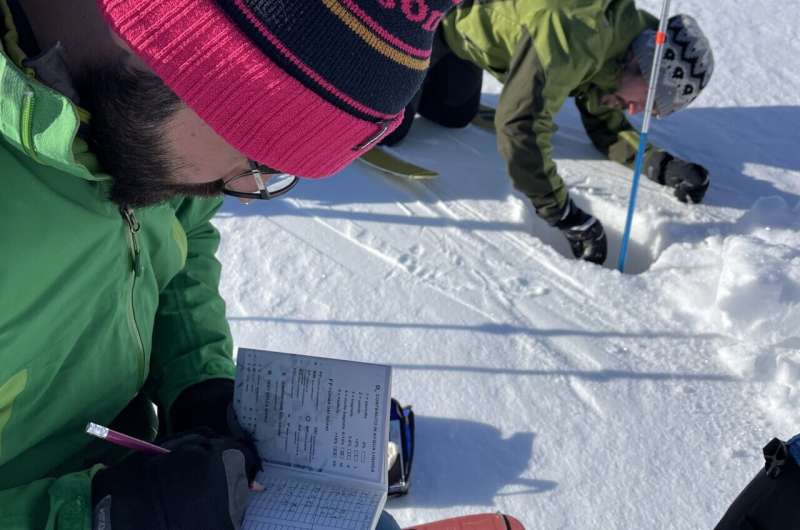This article has been reviewed according to Science X's editorial process and policies. Editors have highlighted the following attributes while ensuring the content's credibility:
fact-checked
proofread
New satellite technology tested in the Schnalstal/Senales valley to measure thermal conductivity of snow

Over the past few days, a small Cessna aircraft carrying an experimental technology flew over the Senales Valley in South Tyrol between Vernago Lake and Grawand. Over the course of two flights, a sensor measured the heat exchange between snow and air.
On the ground, along the same routes, eight teams led by Eurac Research experts measured snow depth with scaled rods and weighed the snow to determine its type. If analysis of the data collected proves the technology is reliable and the measurements match those taken on the ground, it could go on to be mounted on satellites.
For weeks, emails among researchers had been going back and forth: "There is a possible window next week," "Canceled: bad weather on the way," "We'll try again as soon as high pressure returns." Then, finally, the announcement: "We've got the go ahead for tomorrow." The emails take on a new tone. Checklists for equipment, updated checklists for equipment, flight plans, safety arrangements for the umpteenth time.
At first light on April 4th, the first group sets off loaded with skis, ski skins and backpacks. Soon after, a small Cessna aircraft takes off from Trento's airport. On board, technology to be tested.
The first flight arrived in the valley around 7 a.m., the second around 1 p.m. During each flight the Cessna zigzagged over the area at an altitude of 5,000 meters for about 40 minutes. For the research team, having the same flight at different times of the day was critical.
"Until now, to monitor snow we have used satellite images that measure direct properties such as depth and density," explains Carlo Marin, a remote sensing engineer at Eurac Research.

"Instead, this technique developed by University Milano Bicocca measures how the snow breathes, that is, the heat exchange between the snow and the air. From this information we can gauge properties such as density and type of snow. In the early morning flight, the temperature is cooler, and in the warmer hours of the day, the surface layer of snow is warmer due to higher temperatures and sunlight. The difference in temperature relates to how different types of snow exchange heat with their surroundings."
"In addition, the experimental sensor images promise very high resolution."
As the small Cessna plane flew along 12 strips technically known as "transects," 22 people were in place on the ground to measure the depth of the snow and its weight at three-meter intervals. And by doing so, were able to determine the snow density: the wetter being heavier, the lighter, powdery and finer.
Some research teams were not far from lifts, but others had to reach remote spots, such as the Teufelsegg peak, in below the Weisskugel/Palla Bianca (3,738 m), by trekking for hours with skis, ski skins and backpacks loaded with equipment. One team was also accompanied by technicians carrying the same type of sensor as the one mounted on the plane to further corroborate the measurements from the ground.
In the coming months, the research team will cross-reference the measurement results and test whether the technology is mature enough to be installed on a satellite and become operational.
"In light of the climate crisis making water an increasingly scarce and valuable commodity, carefully calculating the presence of snow, especially at high altitudes, will become increasingly important in more accurately estimating the availability of water for the summer season and as such, give support to those who have to administer this resource," concludes Marin.
Provided by Eurac Research




















